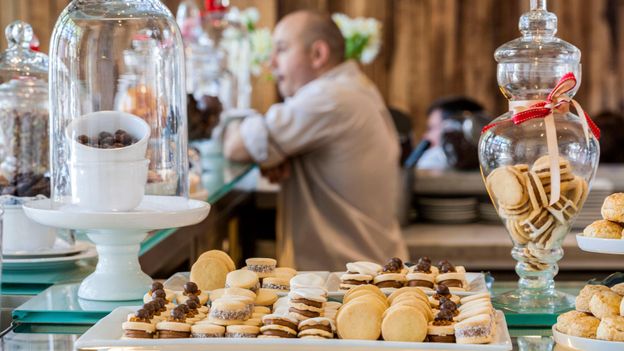Gooey ‘biscake’:
“Alfajores are synonymous with Argentina – the biggest producer and consumer – roughly a billion alfajores are sold in Argentina every year, with hundreds of varieties available.”
The following written content by Shafik Meghji
Chocolatier Maria Romero’s eyes gleamed as she drifted back to her childhood in Quilmes, a city in Buenos Aires province, and her first encounters with alfajores. “My first memory of eating them was when I was little,” she said. “We had these kioscos [small convenience stores] inside the school and would run over at breaktime to buy an alfajor. I have a very strong memory of standing and listening to the children shouting out the names of the different brands – Jorgito, Capitán del Espacio, Fantoche. If you were hungry, needed something sweet, felt sad, you bought one. Sometimes you just need an alfajor to survive.”
In its most common form, an Argentine alfajor is a pair of soft, crumbly biscuits sandwiching a layer of dulce de leche (a thick, super-sweet caramel-like confection) and covered with chocolate or dusted with sugar or desiccated coconut. Romero describes alfajores as “biscakes” – a cross between a biscuit and a cake – and has turned them into a career. After working for the likes of the Savoy in London, luxury chocolate-makers Artisan du Chocolat and Rococo and the Hilton in Buenos Aires, she now runs UK-based Sur Chocolates, which produces gourmet alfajores.
Romero places alfajores alongside Malbec wine, beef and yerba mate (an incredibly popular herbal tea) in Argentina’s culinary pantheon – and she’s not alone. Approximately one billion alfajores are sold in Argentina every year, according to the Buenos Aires tourist board, and hundreds of varieties are available in kioscos, supermarkets and bakeries across the country, from the icy realms of Tierra del Fuego in the far south to the high, arid plains of Jujuy in the extreme north.
“You can find them everywhere,” said Buenos Aires-based food writer and Pick Up The Fork blogger Allie Lazar. “Every kiosco sells a great selection of alfajores. Most Argentines have quite the sweet tooth and dulce de leche is basically a national treasure, so alfajores have long been the perfect quick treat or snack. They’re also a great accompaniment to contrast yerba mate, which tends to be quite bitter.”
Alfajores are commonly filled with a layer of dulce de leche then covered with chocolate or dusted with sugar or desiccated coconut. Read more from BBC.






